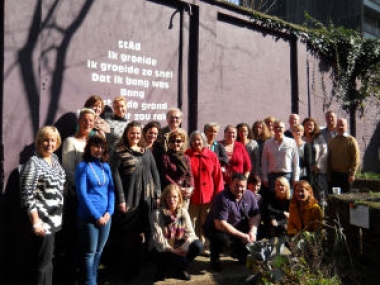In Antwerp: SI’s, GPS and the 7 dimensions
Edited on
05 February 2015During the TM in Antwerp (13-14th of March 2014) was the first of 2 transnational meetings about policy recommendations.

SI’s :
The particular structural indicators were presented in detail in Gijon and each municipality there was asked if they accepted those and which ones they wanted modified or excluded. Their feedback was taken on board for the attached template that was then used. It was also decided then to distinguish between core and optional structural indicators.
It is expected that municipalities would address the core structural indicators and if they are not adopting specific ones that they would offer explicit and transparent reasons why they are not adopting any specific core structural indicator.
Paul Downes proposed to share feelings and give explanations about answers to 7 of the questions:
Structural Indicators ( SIs) are based on yes and no-questions, something that can be changed (laws, spaces, roles and responsibilities, key guiding principles, potentially malleable dimensions to a school and/or community system). SIs can operate flexibly at different levels of a system and at different levels of concreteness and abstraction i.e., physical spaces and designated jobs, guiding principles for action/strategy etc.)
Partners had to send their responses to questionnary (cf GPS). 9 did it before TM. Many of them where not so comfortable with the only choice of Yes or No.
It was not so easy to answer yes or no and some partners asked why not havaing a scale from 1 to 5. But Yes or no can also be enough! After yes comes how? If no we have to ask ourselfes why and what to do? Scales are individual thoughts and are not necessary helpful for others!
Feedback would be helpful in identifying places where the wording of the structural indicators can be further tightened. Much depends also on how we hope to use them in future, initially they were being used as a means of self-assessment (and not comparatively) of whether and how strategic issues are being addressed in a specific municipality.
The structural indicators could also be used comparatively to inform the policy report. To do so, we would need to tighten exactly what is meant by a yes or no response. This is quite easy to achieve and could be done at the Munich meeting in june 2014. The policy recommendation report will produced for the end of September 2014.
GPS: The "Guide of Good Practise Source book" ( GPS) was presented by Ulf Hagglund
One of the major activities of the first project phase of the PREVENT network has been the mapping and sharing of good practices related to parental involvement in measures and processes to prevent early school leaving. The mapping work done by cities have been underpinned by a serious ambition to find and disseminate actions, projects and policies that first and foremost are considered useful in the context where they are or have been running. The added value of the mapping exercise is that people involved now have better knowledge and understanding of the range of local resources in each city, what kinds of cooperation are in place – and also, thinking about further development of services, what gaps and challenges that still have to be solved.
This GPSis one of the products delivered by the network.
The Guide of offers a comprehensive section on good practices related to the involvement of parents in preventing early school leaving. But it also offers some useful information, tools and recommendations.
The Guide touches on the PREVENT network learning process; how cities respond to the good practice mapping and dissemination process and what it means in terms of continuation.
The Guide has one part dedicated to analysis and reflection, where thoughts on how the good practices delivered by the PREVENT network cities fit into an ecology of preventive measures, involving parents, aimed at fighting ESL.
Last but not least the Guide introduces the concept of Structural Indicators (SI).
And the 7 dimensions !
Parental involvement is about Partnership / cooperation and the attitude we want to have for well-being of children. That for we need to take into account the 7 dimensions of parental involvement. It’s a conceptual framework to map parental involvement, to come to a multidimensional analysis of the current approach and to come to a multidimensional approach of parental involvement. The 7 dimensions : knowledge, emotion, ratio, competence, behaviour, time
Submitted by admin on




